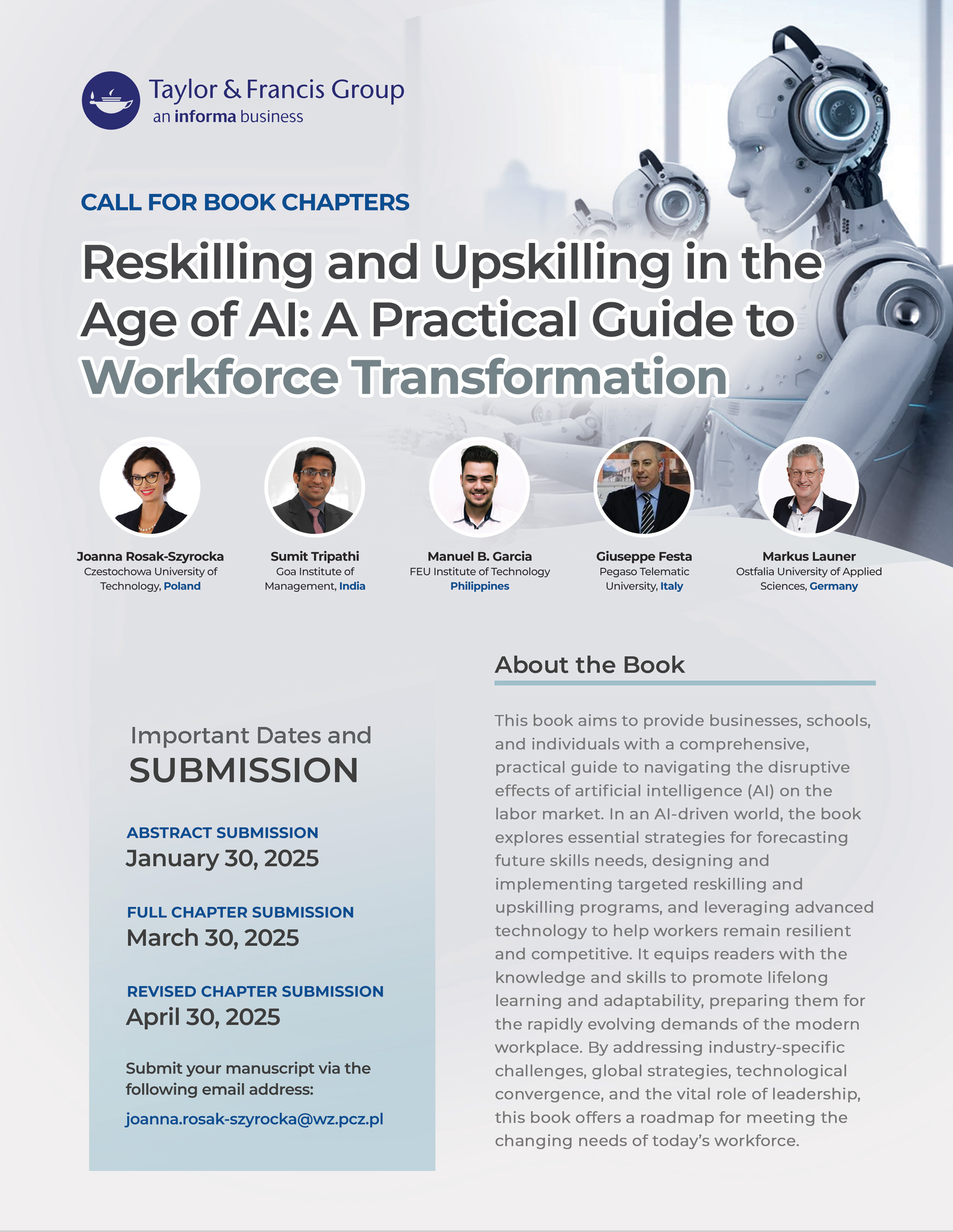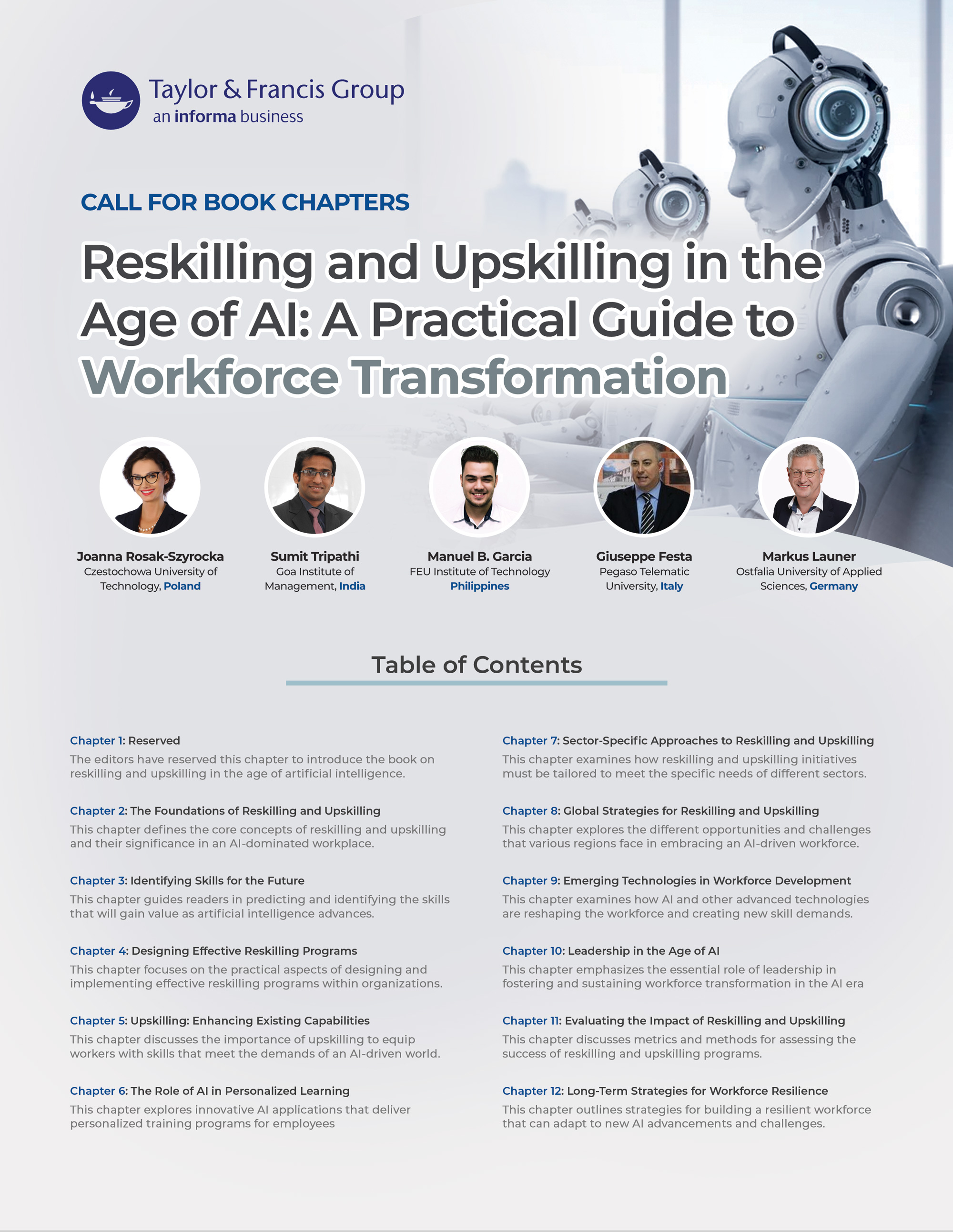Reskilling and Upskilling in the Age of AI: A Practical Guide to Workforce Transformation (Call for Chapters)
Contribute to the discourse on reskilling and upskilling in the age of artificial intelligence by submitting a chapter to this upcoming publication.
Introduction
In an era defined by rapid technological advancements, the emergence of artificial intelligence (AI) is reshaping industries, altering job roles, and challenging traditional skills in unprecedented ways. As AI continues to drive automation, data analytics, and innovation, businesses and individuals face an urgent need to adapt to these changes. Preparing for this transformation requires a fundamental shift in how we approach learning, skill development, and workforce readiness. The speed and scale of AI's impact have presented numerous challenges, particularly in workforce development, where the traditional skills of yesterday may no longer align with the demands of an AI-driven world. To thrive in this new environment, individuals must cultivate a mindset of continuous learning, with an emphasis on reskilling—acquiring new capabilities to transition into different roles—and upskilling—enhancing existing competencies to stay relevant. For businesses and educational institutions, this means redefining training, development, and educational strategies to equip workers for roles that may not have existed a few years ago.

Objective
Recognizing this transformation, the Reskilling and Upskilling in the Age of AI offers a comprehensive, practical guide designed to equip businesses, educational institutions, and individuals with the tools and strategies necessary to navigate the disruptive effects of AI on the labor market. It explores crucial methodologies for predicting future skill requirements, crafting and implementing targeted reskilling and upskilling programs, and leveraging cutting-edge technologies to help workers stay resilient and competitive. By addressing industry-specific challenges, global strategies, and the convergence of AI with other advanced technologies, the book empowers readers to foster lifelong learning and adaptability to meet the evolving demands of the modern workplace. Unique among similar publications, this book provides industry-specific approaches tailored to diverse sectors, recognizing the distinct skill needs that arise from AI’s impact in various fields. Unlike many texts that focus solely on AI or general workforce trends, this book explores the intersection of AI with other innovations, such as blockchain and the Internet of Things (IoT), offering a nuanced perspective on workforce development.
This book stands out through its interdisciplinary, global, and actionable approach to workforce transformation. It adopts a worldwide perspective, exploring the unique needs and strategies of both established and emerging economies—a topic often overlooked in contemporary literature. Additionally, this book emphasizes practical guidance, leadership roles, and ethical considerations in workforce adaptation, setting it apart from more theoretical or generic discussions. By providing a forward-thinking and practical roadmap, this book equips readers with the insights and skills to embrace lifelong learning and prepare for the swiftly evolving demands of today's AI-driven job market.
Target Chapters
Chapter 1: Reserved
Chapter 2: The Foundations of Reskilling and Upskilling
In the framework of an AI-dominated workplace, this chapter defines the fundamental concepts of reskilling and upskilling and explains their significance. The basic tenets of continuous education and lifelong learning are examined as essential elements in workforce transformation. The chapter also discusses how training programs and educational institutions are evolving to meet the needs of artificial intelligence, providing a strong basis for practical strategies. Case Study: Siemens and Initiatives for Lifelong Learning - This case study highlights Siemens’ approach to fostering a culture of lifelong learning to stay competitive in the face of AI developments.
Chapter 3: Identifying Skills for the Future
This chapter guides readers in predicting and identifying the skills that will gain value as artificial intelligence advances. Techniques for assessing the talent needs of various industries, both current and future, are explored. The chapter emphasizes the importance of collaboration among businesses, academic institutions, and industry professionals to develop and enhance skill sets that meet evolving demands. Readers will learn how AI can help industries plan for workforce development and forecast the skills required for the future. By anticipating key skills, businesses can leverage machine learning insights to stay ahead of the competition. Case Study: IBM's SkillsBuild Program - IBM anticipates and meets future skill demands by identifying and nurturing future talent through internal initiatives and partnerships with educational institutions.
Chapter 4: Designing Effective Reskilling Programs
This chapter focuses on the practical aspects of designing and implementing effective reskilling programs within organizations. It provides methods for creating programs aligned with workforce aspirations and company objectives. Additionally, it examines how public-private partnerships and government policies support large-scale reskilling initiatives, offering insights into maximizing their impact. Case Study: Unilever's Global Reskilling Initiative - This case study explores Unilever’s global reskilling program, which leverages AI to identify skill gaps and align training with business needs.
Chapter 5: Upskilling: Enhancing Existing Capabilities
Chapter 5 discusses the importance of upskilling to better equip workers with current skills that meet the demands of an AI-driven world. The chapter explores how AI can customize career objectives and upskilling paths by tailoring instruction to each learner's unique strengths. This approach not only keeps employees competitive but also fosters professional growth within the organization. Learn how AI-powered learning systems maximize skill development by adapting instruction to each learner’s abilities and pace, promoting agility and competitiveness in a dynamic workplace. Case Study: Google's AI-Powered Staff Development - Google uses AI to customize employee upskilling paths, demonstrating how personalized learning enhances worker capabilities and career growth.
Chapter 6: The Role of AI in Personalized Learning
This chapter explores innovative AI applications that deliver personalized training programs for employees. It examines how AI assesses each learner's needs, learning preferences, and progress to create individualized training plans that maximize effectiveness. Ethical considerations, including biases and data protection, are also discussed to ensure responsible use of AI-driven personalized learning. Case Study: Coursera's Personalized Learning Platform - This case study demonstrates the scalability and effectiveness of AI-driven education by showcasing how Coursera provides individualized learning experiences to millions of users.
Chapter 7: Sector-Specific Approaches to Reskilling and Upskilling
This chapter examines how AI-powered reskilling and upskilling initiatives must be tailored to meet the specific needs of different sectors. It aims to give readers insights into the unique opportunities and challenges that various industries—including healthcare, manufacturing, education, and finance—face in incorporating AI into their operations. The chapter presents industry-specific examples and case studies, showing how tailored workforce development programs align with industry demands and emerging trends.
Chapter 8: Global Strategies for Reskilling and Upskilling in the Age of AI
This chapter explores the different opportunities and challenges that various regions face in adapting to AI-driven workforce changes. Regional Differences: Examines variations in reskilling needs between developed and emerging economies, considering demographics, education systems, and tech infrastructure. Case Studies: Highlights successful reskilling initiatives from around the world and the lessons other regions can draw from these models. Policy Approaches: Discusses how international cooperation and government policies support large-scale reskilling initiatives, with attention to regional differences. Cultural Considerations: Explores how cultural factors influence AI adoption and openness to reskilling programs. Future Trends: Examines global economic shifts and AI advancements impacting the future workforce, underscoring the need for continuous adaptation.
Chapter 9: Technological Convergence: AI and Emerging Technologies in Workforce Development
This chapter examines how AI and other advanced technologies, like robotics, blockchain, AR, and IoT, are reshaping the workforce and creating new skill demands. By exploring specific examples and use cases, this chapter shows how technology integration is altering job roles and requiring targeted reskilling and upskilling initiatives. It aims to prepare individuals and organizations to take advantage of these advancements in a rapidly changing technological landscape.
Chapter 10: Leadership in the Age of AI: Guiding Workforce Transformation
This chapter emphasizes the essential role of leadership in fostering and sustaining workforce transformation in the AI era. It provides strategies for leaders to cultivate a culture of continuous learning and adaptability. Additionally, it underscores the importance of ethical leadership in managing AI integration responsibly. Case Study: Microsoft's Leadership in Workforce Transformation - Analyzes Microsoft’s approach to integrating AI into global operations and guiding workforce transformation through a robust ethical framework.
Chapter 11: Measuring Success: Evaluating the Impact of Reskilling and Upskilling
This chapter discusses metrics and methods for assessing the success of reskilling and upskilling programs. It introduces key performance indicators (KPIs) that help organizations evaluate the return on investment for workforce development initiatives and emphasizes the importance of continuous feedback loops to keep learning programs aligned with evolving business needs. Case Study: PwC's Training Effectiveness Metrics - Shows how PwC uses data and KPIs to assess the effectiveness of its reskilling programs, offering insights for organizations on measuring and refining their efforts.
Chapter 12: Preparing for the Future: Long-Term Strategies for Workforce Resilience
Taking a forward-looking approach, this chapter outlines strategies for building a resilient workforce that can adapt to new AI advancements and challenges. It highlights the importance of long-term workforce planning, which includes continuous upskilling and reskilling efforts. By examining emerging AI technologies and their potential impact on the workforce, the chapter equips readers with insights to future-proof their organizations in an AI-driven world. Case Study: Tesla's Future-Proofing Employee Strategy - Highlights Tesla's approach to preparing its workforce for AI-driven manufacturing, including long-term planning and continuous skill development.

Submission Procedure
Researchers and practitioners are invited to submit on or before January 30, 2025, a chapter proposal of 1,000 to 2,000 words clearly explaining the mission and concerns of his or her proposed chapter. Authors will be notified by February 15, 2025 about the status of their proposals and sent chapter guidelines. Full chapters are expected to be submitted by March 15, 2025, and all interested authors must consult the guidelines for manuscript submissions at https://taylorandfrancis.com/who-we-serve/academia/authors/book-authors/publishing-guidelines/ prior to submission. All submitted chapters will be reviewed on a double-blind review basis. Contributors may also be requested to serve as reviewers for this project.
All proposals should be submitted to joanna.rosak-szyrocka@wz.pcz.pl with the following subject: Chapter #: Book Chapter Title.
Publisher
This book is scheduled to be published by Taylor & Francis, a prominent academic publisher with a rich history dating back to 1798. The company offers a wide array of peer-reviewed journals and books across diverse disciplines, including Science, Technology, Medicine, Humanities, and Social Sciences. With a global reach, Taylor & Francis publishes over 2,700 journals and more than 8,000 new books annually, maintaining a backlist exceeding 180,000 titles. Their commitment to advancing knowledge and supporting researchers, educators, and professionals worldwide is evident through their extensive catalog and dedication to quality publishing. For additional information regarding the publisher, please visit https://taylorandfrancis.com/about/. This publication is anticipated to be released in 2025.
Important Dates
- January 30, 2025: Abstract Submission Deadline
- February 15, 2025: Notification of Acceptance
- March 15, 2025: Full Chapter Submission
- April 15, 2025: Review Results Returned
- April 30, 2025: Final Chapter Submission
Editors
![]() Joanna Rosak-Szyrocka
Czestochowa University of Technology, Poland
joanna.rosak-szyrocka@wz.pcz.pl
Joanna Rosak-Szyrocka
Czestochowa University of Technology, Poland
joanna.rosak-szyrocka@wz.pcz.pl
![]() Sumit Tripathi
Goa Institute of Management, India
sumitt.rs.bme17@itbhu.ac.in
Sumit Tripathi
Goa Institute of Management, India
sumitt.rs.bme17@itbhu.ac.in
![]() Manuel B. Garcia
FEU Institute of Technology, Philippines
mbgarcia@feutech.edu.ph
Manuel B. Garcia
FEU Institute of Technology, Philippines
mbgarcia@feutech.edu.ph
![]() Giuseppe Festa
Pegaso Telematic University, Italy
giuseppe.festa@unipegaso.it
Giuseppe Festa
Pegaso Telematic University, Italy
giuseppe.festa@unipegaso.it
![]() Markus Launer
Ostfalia University of Applied Sciences, Germany
m-a.launer@ostfalia.de
Markus Launer
Ostfalia University of Applied Sciences, Germany
m-a.launer@ostfalia.de

